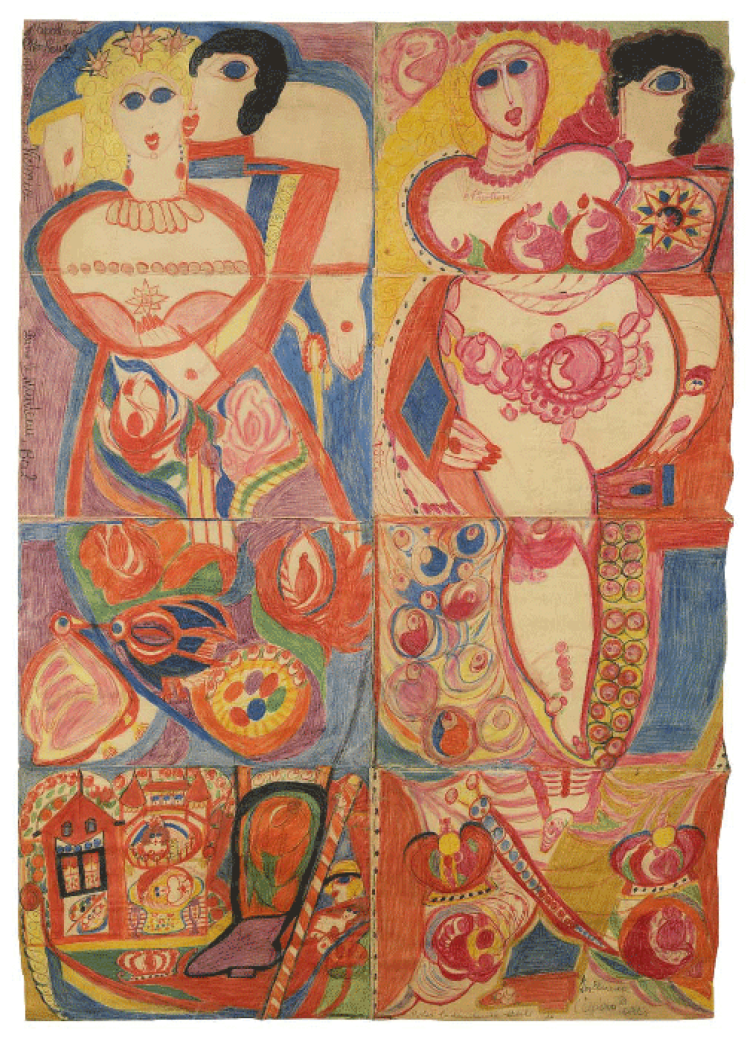Corbaz, Aloïse

Napoléon III à Cherbourg
Aloïse, "Napoléon III à Cherbourg", between 1952 and 1954, coloured pencil and juice of geranium on sewn-together sheets of paper, 164 x 117 cm, © photo credit Collection de l’Art Brut, Lausanne
Author
Corbaz, Aloïse,
(1886-1964), Switzerland
Audio biography
Biography
Aloïse Corbaz, known as Aloïse (1886 - 1964), was born in Lausanne (Switzerland) to a large family of modest means; at thirteen, she lost her mother. At the end of her schooling and one year of boarding school, she found herself at loose ends for some time. Her dream was to become an opera singer and, already then, she began composing religious propaganda. To cut short a relationship of which she disapproved, her elder sister ordered Aloïse to leave for Germany; there Aloïse worked as a governess in various situations, including a stint in Potsdam, in William II's court. Thereupon, she fell in love with the emperor, imagining a torrid love affair with him. The war's outbreak obliged her to leave the country hurriedly. Back in Switzerland, she showed signs of such exalted religious and pacifist feelings that she was committed to the Cery-sur-Lausanne asylum in 1918, followed by the La Rosière Asylum in Gimel-sur-Morges, where she would remain until her death.
Shortly after entering the hospital, she began writing and drawing. Until 1936, she did so in secret, using lead pencil and ink. At times, too, she resorted to flower petal juice, as well as crushed leaves and toothpaste. She used wrapping paper, sometimes sewn with thread, in order to achieve large formats; and, too, envelopes, pieces of cardboard and the backs of calendars. Often as well she used sketch books, which came to represent a specific sector of her oeuvre. She developed a fantasized world in these, often favoring the support's vertical direction. Aloïse created a personal cosmogony filled with princely and political figures — like Napoleon Bonaparte, for instance, and blue-eyed historical heroines — like Marie-Antoinette and Queen Elizabeth.
Shop
- Dubuffet & l'Art Brut (Exhibition catalogues)
- Aloïse II (publications)
- Aloïse III (publications)
- Hans Steck ou le parti pris de la folie (Exhibition catalogues)
- Aloïse et le théâtre de l'univers (publications)
- Aloïse. Le ricochet solaire (Exhibition catalogues)
- Aloïse (publications)
- Aloïse - Le ricochet solaire ( Large format poster)
- Brut writings speak out (Écrits brut)
- Vehicles (french version) (Exhibition catalogues)
- Vehicles (Exhibition catalogues)
- Architecture (Exhibition catalogues)
- Jean Dubuffet's Art Brut, the origins of the collection (2016) New edition 2020 (Books about Art Brut)
- Architecture (english version) (Exhibition catalogues)
- People (Exhibition catalogues)
- Almanach de l'Art Brut (Books about Art Brut)
- Aloïse - Le ricochet solaire (Small posters)
- The Art Brut Fascicle N°07 (The Art Brut Fascicles)
- Corps (french version) (Exhibition catalogues)
- Body (english version) (Exhibition catalogues)
- Le corps dans l'Art Brut (Children's book)
- Notebook "Aloïse" (Other)
- Art Brut Swiss Made (FR) (Exhibition catalogues)
- Art Brut Swiss Made (EN) (Exhibition catalogues)
- Art Brut Swiss Made (IT) (Exhibition catalogues)
- Art Brut Swiss Made (DE) (Exhibition catalogues)
- Théâtres (french version ) (Exhibition catalogues)
- Theatre (englixh version) (Exhibition catalogues)
- Écrire en dessinant. Quand la langue cherche son autre (édition française) (Exhibition catalogues)
- Writing by Drawing. when Language Seeks Its Other (English version) (Exhibition catalogues)
- Pathologie du cadre (Exhibition catalogues)
- Croyances (french version) (Exhibition catalogues)
- Beliefs (english version) (Exhibition catalogues)
Exhibition(s) at the Art Brut Collection
- 5th Art Brut Biennial: Beliefs
- Art Brut: Frame Work
- 4th Art Brut Biennial: Theatre
- Acquisitions 2012-2018
- 3ème biennale de l'Art Brut: Corps
- People - 3 july through 13 november 13, 2016
- Jean Dubuffet´s Art Brut, the Origins of the Collection - extended until september 25, 2016
- Architecture - 13.11.2015 - 17.04.2016
- Vehicles
- Aloise. The Solar Ricochet
- Dubuffet & Art Brut
- Face-to-Face with Art Brut







